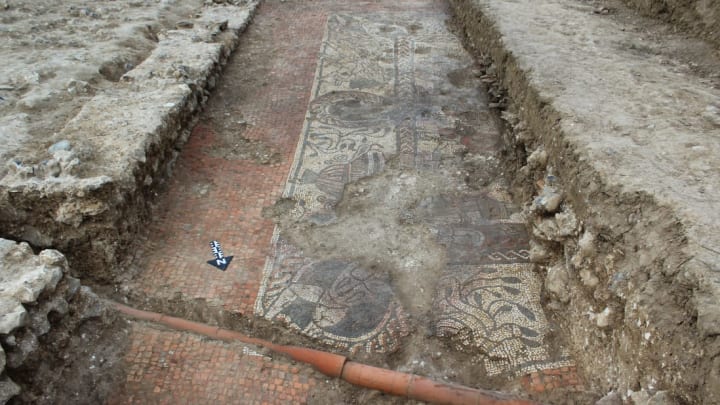For the past three years, amateur archaeologists and historians in southern England have been working side-by-side with volunteers to excavate several seemingly related local Roman sites. Now, just two weeks before the dig's scheduled conclusion, they've made a fantastic discovery: a rare 4th-century CE mosaic that is being hailed as "the most important of its type in Britain in more than half a century," according to The New York Times.
Dating to roughly 380 CE, the mosaic was unearthed near the village of Boxford in Berkshire. The project—which included a rotating assembly of 55 members—involved local interest groups like the Boxford History Project and the Berkshire Archaeological Research Group, and was overseen by Cotswold Archaeology, a company that helps builders preserve archaeological finds. Funding was provided by the Heritage Lottery Fund, which gives grants to heritage projects across the UK.
In the project's first two years, the group members discovered a large Roman villa, a bathhouse, and a farmstead. In 2017, they began excavating the main villa, a site that yielded pottery, jewelry, coins, and other ancient objects. None of these artifacts, however, were as spectacular as the mosaic, which volunteers unearthed in a moment of serendipity shortly before funding for the dig ended.
Revealed sections of the artwork depict scenes featuring Bellerophon, a mythological Greek hero, along with other fabled figures. Bellerophon is famous in legends for capturing the winged horse Pegasus and for defeating the Chimera, a fire-breathing creature with a lion's head, a goat's body, and a serpent's tail.

"The range and style of imagery is very rare in the UK, where simple geometric patterns are the norm," Duncan Coe, a principal heritage consultant with Cotswold Archaeology, tells Mental Floss. "The combination of artwork and inscriptions is unique in this country. The range of imagery is also unique, with at least two scenes from the story of Bellerophon, a character from Greek mythology, augmented by Hercules and the Centaur, Cupid and telamones [male statues used as a column]—and we only have half of the mosaic revealed so far."
Excavators uncovered nearly 20 feet of the mosaic, but ultimately reburied it to deter looters and prevent damage. Members of Boxford's local archaeological community hope to secure funding and return to the site—now dubbed the Boxford villa—to dig up the entire scene.

In addition to teaching experts about the villa's owners—who were evidently sophisticated and wealthy—and Boxford's ancient heritage, the newly discovered mosaic isn't just any ordinary artwork, according to Coe: "This isn't just an isolated mosaic, but a small, but very important, part of a bigger jigsaw that advances our understanding of what was happening in southern England just before the Roman government abandoned Britain," he says.
[h/t The New York Times]
